[Updated December 26, 2018]
You’ll never hear me say that coercive dog training methods don’t work; they can. Nor will you ever hear me say that positive training turns every dog into a model canine citizen. It doesn’t.
There is a big difference, however, between positive and coercive dog training. When methods that rely on the use of force and application of pain fail, it’s often because of the dog’s inability to tolerate coercion and intimidation. This can result in serious long-term behavioral damage and sometimes physical injury.
Dogs at the assertive end of the canine personality continuum may fight back assertively against coercive techniques, while those who are too soft to tolerate physical punishment may bite defensively or simply shut down. Positive dog training methods, however, are most likely to fail because of mistakes made in the implementation of the method. If you misuse your clicker (clicker training) and treats you may end up with a fat, happy, out-of-control dog, but you’re far less likely to do any long-term physical or psychological damage.
The ideal, of course, is to have a healthy, happy, well-behaved dog. In order to accomplish this with positive training methods, you’ll want to be sure to avoid the common mistakes described below.
Mistake #1: Confusing Positive Conditioning with Permissiveness
You may hear non-positive trainers insist that there has to be a negative consequence for a dog’s inappropriate behavior or he’ll never learn what’s not allowed. It might surprise you to hear that positive trainers don’t disagree. We just differ on the nature of the consequence. A well-implemented positive training program combines good management, to prevent the dog from having the opportunity to be reinforced for undesirable behavior, and negative punishment, in which the dog’s inappropriate behavior makes a good thing go away. Consider this comparison:
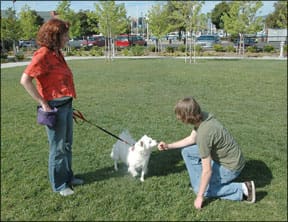
Coercive dog training – Dog is on leash, goes to jump up on an approaching pedestrian. Handler gives a sharp correction (punishment) by jerking hard on the leash. Jumping up is punished; dog learns that bad things happen if he tries to jump up. Note that he may also learn that approaching people makes bad things happen, a possible foundation for future aggressive or fearful behavior with strangers.
Positive dog training – Dog is on leash, goes to jump up on an approaching pedestrian. Handler restrains dog so he can’t reach the stranger, and asks the stranger to stop and wait for the dog to sit before petting. Jumping up is managed; dog learns that jumping up gets nothing, but sitting makes good things happen, a foundation for future good manners/ polite greeting behavior.
Permissive dog training – Dog is on leash, goes to jump up on approaching stranger. Handler allows dog to jump up and stranger pets dog. Jumping up is reinforced; dog learns that jumping up makes good things happen, and will continue to jump up to greet visitors, perhaps even intensify his efforts to jump up.
Management plays a vital role in the “positive doesn’t equal permissive” piece of positive training. By removing the positive reinforcement for unwanted behaviors, you prevent your dog from being rewarded by them. This is true whether you’re restraining with a leash to prevent jumping up, crating to stop adolescent house-destruction, clearing tables to manage counter-surfing, putting tempting objects out of reach to avoid chewing, or any of a long list of other management applications.
Behaviors that aren’t rewarded in some way eventually extinguish, especially if you make it a point to reinforce an alternative and preferably incompatible behavior.
Mistake #2: Dependency on Luring
Unless you’re a dedicated pure shaper, if you train with positive methods you probably use luring to some degree.
Luring is using a treat to show your dog what you want him to do. To lure a “down,” for example, hold the treat in front of your dog’s nose while he’s sitting, then lower it a tiny bit toward the floor. As his nose follows the tidbit, “mark” the behavior that you want with the click! of a clicker or a verbal marker, such as the word “Yes!”, and feed him the treat.
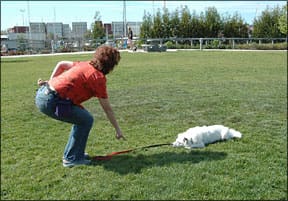
Continue gradually moving the treat toward the floor, clicking and treating along the way, until he’s lying down. If at any time he stands up, say “Oops!” and have him sit again, then resume luring the down, moving the treat toward the floor in smaller increments this time.
Luring to teach behaviors is just fine. Forgetting to “fade” (gradually remove) the lure is not. If you don’t fade the lure early in the training process, you and your dog can become dependent on the presence of treats to get the behavior to happen. While I almost always have treats in my pockets or close by, I don’t want to have to rely on treats to get my dog to offer behaviors when I ask for them.
Here’s how to fade the lure with the “down” behavior:
1. Use the lure until the “down” happens easily – when you lure to the floor your dog follows into a down position immediately, with one click! and treat at the end. For most dogs this should only take a half-dozen or so repetitions.
2. Stand in front of your dog with your hands at your sides, a treat in the hand you’ve been using to lure with. If your dog mugs that hand for the treat, hide it behind your back.
3. With your dog sitting in front of you, ask for the “down.”
4. Wait a second or two, and if he doesn’t lie down (he probably won’t), lure him to the ground.
5. Repeat Steps 3 and 4 several times, sometimes waiting a little bit longer to lure, sometimes a little shorter.
6. If he’s not lying down when you ask after a half-dozen repetitions, start fading the lure in gradual steps. Ask for the “down,” pause, and when you lure, instead of moving the treat all the way to the floor, move it three-quarters of the way, and then whisk it behind your back, parallel to the floor (if you lift it up you’ll lure him back into a sit). Since he’s three-quarters of the way down, he’s likely to continue all the way to the floor, even though the treat is gone. If not, repeat again and go seven-eighths of the way to the floor.
7. Repeat Step 6, gradually decreasing the distance you lure toward the floor, until you’ve faded the lure completely.
You can apply this same process to any behavior you teach initially by luring. As soon as the dog can perform the behavior easily for the lure, begin fading. You are, in essence, translating for your dog, showing him that the word you’re using is the equivalent of the lure. When you say the verbal cue “down,” pause, and then lure, it’s as if you’re saying, “Dog, the word down means exactly the same thing as putting the treat in front of your nose and moving it toward the floor.”
Mistake #3: Dependence on Treats
Even if you do a good job of fading the lure, you can still find yourself dependent on treats – feeling like you have to click! and treat your dog every time he performs, or the behavior might go away.
This is known as a continuous schedule of reinforcement (CSR). Dogs can achieve superb, reliable behaviors on a CSR, but the behaviors are probably not very durable. If for some reason you stop giving a click! and treat for each repetition of the behavior, the dog will probably stop doing as you ask in fairly short order, since he no longer gets his primary reinforcer (the food).
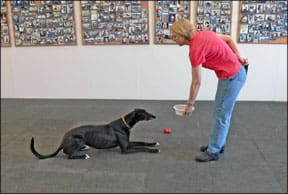
Enter the very important concept of intermittent reinforcement. When your dog performs reliably on a CSR, that is, offers the desired behavior in response to your cue at least eight out of ten times, it’s time to start reinforcing intermittently. In plain English, that means every once in a while you skip a click! and treat, and praise your dog instead. At first just skip an occasional click!, and as you practice this, over time you can skip more and more, until your dog works primarily for praise (or other life rewards).
If you include praise regularly as part of your clicker training – click!, treat, “Good dog!” your dog will have a very positive association with praise, and it will still have value even when the click! and treat are absent.
Note: In my training, a click! always means a food treat is coming. When I start using intermittent reinforcement, I don’t click! if I’m going to use praise alone. This helps to maintain the value and power of the clicker.
You can use other rewards as well, when you want to reinforce without a click! and treat. Anything your dog loves can be used as a reinforcer if you can figure out how to control your dog’s access to it and use it to reward desirable behaviors: a ball, a favorite toy, a car ride, a walk on-leash, or a scratch behind the ear.
Sometimes I reinforce my dogs for waiting politely at the door by opening the door and telling them they can run through. They get to dash outside and poop, pee, and play. These are all valuable “life rewards” – things that are naturally reinforcing to dogs.
Of course, sometimes they don’t get to run out the door. Intermittent reinforcement makes a behavior very durable. Like a gambler at a slot machines, your dog will keep playing the game because he’s learned it will eventually pay off.
Mistake #4: Poor Timing
Some trainers will tell you the consequence must happen within “x” amount of time in order for it to be effective; that is, in order for the dog to understand the connection between the behavior and the reward (or punishment). I’ve heard as much as five seconds (which I would suggest is far too long) and as little as one second (which is much more likely to be accurate).
Suffice it to say that the results are optimal when the consequence happens as close to the instant the behavior happens as possible. This is true whether the consequence is positive reinforcement (treat, praise, toy, play, petting), negative punishment (where the dog’s behavior makes a good thing go away), or “positive punishment” (where the dog’s behavior makes a bad thing happen). Of course, positive trainers studiously try to avoid using positive punishment.
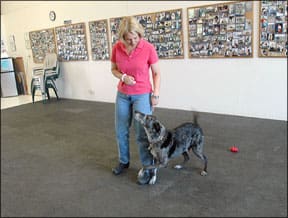
The greatest value of a reward marker – such as the click! of a clicker or the word “yes!” – is that it enables you to have perfect timing. With a marker, you can always have perfect, or at least near-perfect timing, because the marker bridges the time gap between the behavior and the delivery of the treat. Of course the marker still has to be given the instant the behavior happens – or very close thereto – but it gives you a few seconds of breathing room in which to deliver the treat.
If you have poor timing, you may inadvertently but consistently reinforce a behavior other than the one you want your dog to perform. At best, this is confusing for the dog, slows learning, and is frustrating for both of you. At worst, you might reinforce the exact opposite of the behavior you’re trying to teach, and end up training your dog to do an entirely different behavior, perhaps even a highly undesirable one!
Let’s say you’re trying to teach your dog the polite greeting behavior of “sit” when he approaches visitors in your home. When your guests arrive, you have him on leash so you can manage his jumping up behavior. As your first guest enters the door, your dog executes a brilliant “sit” on the doormat! You fumble for your clicker, and just as you press the metal tongue he decides he’s not getting reinforced for the sit and jumps on Aunt Martha. Click! – and major oops! Of course you haven’t done terminal damage – unless Aunt Martha is 90 years old and breaks her hip when your dog knocked her down. But every time you’re too slow with your marker and it arrives when your dog is jumping up instead of sitting, you’re telling him that jumping is a good thing to do; it earns a marker and reward!
Herein lies one of the values of having a verbal marker, such as the word “Yes,” or a clicking sound you make with your tongue. If you’re caught off guard and you don’t have your clicker handy – just let loose your verbal marker and follow with one of the treats you always have in your pocket.
If you realize your timing is sloppy even with your clicker ready in hand, then do some clicker-timing practice. With your dog out of earshot, turn your television onto the sports channel and find a tennis match. Watch closely. Every time a player hits the ball, click! your clicker. When your click! regularly coincides with the “Thwack!” of the ball hitting the racket, you’re ready to go back to work with your dog. (Note: this sort of practice isn’t nearly as effective with golf or baseball.)
Mistake #5: Lacking Sufficient Courage of Your Convictions
When you’re training your dog and things don’t seem to be working as they should, it can be tempting to let yourself be led astray. You can always find a ready supply of friends, family members, and other animal care professionals who are happy to tell you that you need to correct, alpha roll, intimidate, and/or shock your recalcitrant dog into submission.
Perhaps you’re a crossover trainer and even your own past success using forceful methods prompts that little voice in your brain to say, “I could just jerk his collar one time…”
STOP!
One of the things we value so much about positive training is the trust it builds between dog and human. Your dog trusts that he can try behaviors without getting hurt – you’ll let him know when he’s right, but you won’t frighten or hurt him when he’s wrong. When you violate that trust, you risk negative behavioral consequences that are sometimes significant, ranging from aggression at one end of the spectrum, to shutting down, or learned helplessness, at the other.
When a dog becomes aggressive, his future becomes questionable. When a dog shuts down, losing his willingness to offer behaviors for fear he’ll be punished, it makes his training even more frustrating.
Aggression aside, using coercion along with positive training has serious consequences. If you punish your dog for failing to perform a cue that you “know” he knows, you “poison” that cue; in other words, you give him a negative association with it. The cue becomes ambiguous; the dog doesn’t know if it predicts “good stuff” (click! and treat) or “bad stuff” (punishment). This ambiguity creates stress, and can turn a happy working dog into one whose tail starts to lower and enthusiasm starts to wane.
A poisoned cue is very difficult, if not impossible, to rehabilitate. If you poison a cue you’re better off introducing a new one than trying to regain the consistently positive association with the old one.
You always have a choice as to how to behave with your dog. One of the many things I love about positive training is that if one way isn’t working, there are many more possibilities to try to get the behavior you want to reinforce, without resorting to coercion or intimidation. Use of force in an otherwise positive training program is detrimental to future training, as well as evidence of lack of creativity and lack of commitment to a pain/intimidation-free relationship with your dog.
At a recent seminar, the owner of a lovely Bernese Mountain Dog admitted to me that he “had” to use a forced retrieve (ear pinch) on his otherwise positively trained dog. I gently suggested that he didn’t “have” to, but rather he “chose” to use this pain-inducing method. I wasn’t surprised when we got to the shaping exercise in the seminar and the Berner sat next to his owner, staring unwaveringly into his eyes, not offering a single bit of behavior, while the rest of the dogs in the group happily engaged in the shaping game and learned to move toward, and eventually onto, their mats. His choice definitely affected his dog and their relationship.
Positive works. If you’re committed to positive training, you can find a way to teach a retrieve without pinching your dog’s ear, or overcome your own training challenge. There are plenty of great books, videos, positive trainers, and supportive e-mail lists that can help you through your training program. Or you can decide that teaching the retrieve isn’t important enough to lose your soul over, and find something else to do with your dog that doesn’t “require” the infliction of pain. It’s your choice. Choose wisely.
DOG TRAINING MISTAKES: OVERVIEW
1. Review your own training program to identify which of the training mistakes you might be making.
2. Implement changes to your training protocols to help you avoid the mistakes and improve the efficacy of your training.
3. If necessary, renew your commitment to positive training methods that encourage a relationship between you and your dog based on mutual trust, cooperation, and respect.
Special thanks to trainers Ruthanna Levy of Alameda, CA, and Sarah Richardson of Chico, CA, for demonstrating proper positive training techniques for this article.
Pat Miller, CBCC-KA, CPDT-KA, is Whole Dog Journal’s Training Editor. Miller lives in Hagerstown, Maryland, site of her Peaceable Paws training center. She is also the author of The Power of Positive Dog Training and Positive Perspectives: Love Your Dog, Train Your Dog.



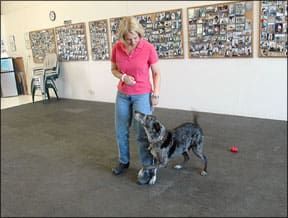



Hi, this is a great article! Thanks for the tips.
One question regarding timing: how quickly does the treat need to be delivered in marker training? I have been told that it needs to happen within a couple of seconds of the behavior. is this the case? I would think the more important factor would be the timing of the marker rather than the reinforcement as the marker is what tells the dog whether or not he has performed a desired behavior.
Thank you for your help!
Hi there,
Great read thank you. I’m using a clicker + treats to train my rescue dog for the last 2 years, she had a very tough early life with little or no socialisation I reckon. She’s very enthusiastic, wants to please but am still having trouble with her lunging at dogs, barking at small children. This is from our doorstep, haven’t quite got out yet for a walk on the pavement! She’s less reactive if we/she is sitting in the open front window. Any suggestions, maybe I’ve moved outside too quickly? Thanks
Nice tips!
People set out with the best intentions in the world when it comes to training their dogs. They see dog trainers on TV or they read about dog training on the Internet and it looks so easy. So, what goes wrong? What are the most common dog training mistakes?
Some of the things that happen to sabotage your efforts to train your dog to occur before you ever put a leash on your dog.